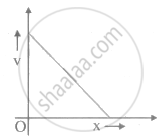Advertisements
Advertisements
प्रश्न
Derive the following equation of motion by the graphical method : v2 = u2 + 2as, where the symbols have their usual meanings.
उत्तर

In the given figure, the distance travelled (s) by a body in time (t) is given by the area of the figure OABC which is a trapezium.
Distance travelld = Area of the trapezium OABC
So, Area of trapezium OABC,
= `"(Sum of parallel sides)(Height)"/2`
=`"(OA+CB)(OC)"/2`
Now, (OA + CB) = u + v and (OC) = t.
Putting these values in the above relation, we get:
`s = ((u+v)/2)t` ....(1)
Eliminate t from the above equation. This can be done by obtaining the value of t from the first equation of motion.
v = u + at
So,
`t = "v-u"/a`
Now, put this value of t in equation (1), we get:
`s = (((u+v)(v-u))/(2a))`
On further simplification,
2as = v2 – u2
Finally the third equation of motion.
`v^2 = u^2 + 2as`
where
(s) - Displacement
(u) - Initial velocity
(a) - Acceleration
(v) - Final velocity
(t) - Time taken
APPEARS IN
संबंधित प्रश्न
Multiple choice Question. Select the correct option.
What does the area of an acceleration – time graph represent?
Draw velocity – time graph for the following situation:
When a body is moving with variable velocity, but uniform acceleration.
Diagram shows a velocity – time graph for a car starting from rest. The graph has three sections AB, BC, and CD.

In which section, car has a zero acceleration?
From the velocity – time graph given below, calculate acceleration in the region AB.

The area under a speed-time graph in a given intervals gives the total distance covered by a body irrespective of its motion being uniform or non-uniform.
How does the slope of a speed-time graph give the acceleration of a body moving along a straight line?
What can you conclude if the speed-time graph of a body is a straight line sloping upwards and not passing through the origin?
Which of the following graphs represents a motion with negative acceleration?
What can you say about the nature of motion of a body of its displacement-time graph is:
A straight line parallel to line axis?
The given graph shows the variation of velocity (v) with position (x) for a particle moving along a straight line

Which of the following graph shows the variation of acceleration (a) with position (x)?
